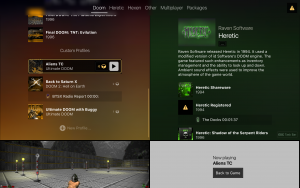The first stable build of Doomsday 2.0 is now available.
The highlighted features of 2.0 are:
- Home Screen replaces the frontend app. A launcher is no longer needed; games and add-ons can be managed using Doomsday itself.
- Built-in support for different data file and package formats. Used packages are tracked in saved games and multiplayer games.
- The new 3D model renderer that has been in development since the 1.15 release is now mature enough for use. It supports FBX and MD5 models, skeletal animation, GLSL shaders, and scripting.
- This is the first 64-bit stable release for Windows.
See the Manual for the complete release notes.
Thanks to everyone who reported bugs in the release candidates! A number of nasty bugs were found and fixed. There is still a few less serious known issues that have been scheduled for next month’s 2.0.1 update.
Work on the 2.x series will now continue along the lines planned in the roadmap, with the first focus area being multiplayer improvements. Under the hood, there is still lots to do with updating remaining old OpenGL rendering code so we can take full advantage of shaders in future releases.




